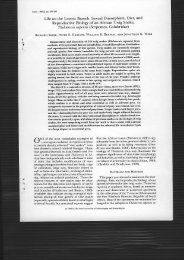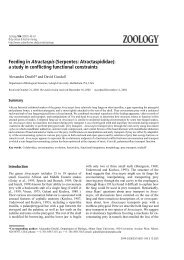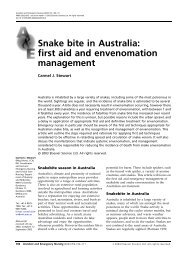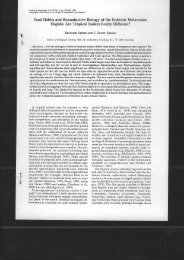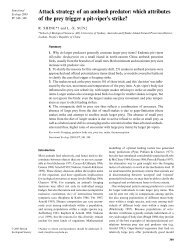Introduction - Kingsnake.com
Introduction - Kingsnake.com
Introduction - Kingsnake.com
You also want an ePaper? Increase the reach of your titles
YUMPU automatically turns print PDFs into web optimized ePapers that Google loves.
Clinical Management of Snakebite in Papua New Guinea Chapter 1<br />
Snakebite in Papua New Guinea<br />
Facts & Fiction<br />
David Williams<br />
<strong>Introduction</strong><br />
Snakes are widely feared in Papua New Guinea, and with very good reason. In many parts of<br />
PNG snakebite is an almost daily occurrence and venomous snakebite is a serious public<br />
health problem, with localized incidence rates that are among the highest of any tropical<br />
region in the world. Medical and epidemiological studies of snakebite in different parts of the<br />
country have given us detailed snapshots of some of the out<strong>com</strong>es of snakebite, and although<br />
there are still many gaps in our knowledge, there is a significant amount of factual data<br />
available.<br />
Ask anyone about snakebite and they will undoubtedly have a story to tell about someone<br />
they know who was bitten by a snake, or who died of snakebite. It would in fact be very easy<br />
to believe that venomous snakes lie in wait for unsuspecting people at every turn, and that<br />
right across PNG snakebite is claiming dozens of lives every day. If you ask Papua New<br />
Guineans about which snakes are responsible for snakebite one species above all others will<br />
feature at the forefront of every conversation; the fearsome ‘Papuan (Pap) black’.<br />
Of course the challenge for clinicians, health workers and scientists when it <strong>com</strong>es to<br />
snakebite is to separate the finely woven threads of fact and fiction:<br />
• Just how many people really are bitten by snakes, and in what parts of the country do<br />
these bites occur?<br />
• Are there as many deaths as either the scientific data, or the local people would have<br />
us believe?<br />
• Which species are dangerous and bite the most people and which are not?<br />
• What types of antivenom will best suit the needs of certain areas of the country?<br />
We have to be able to answer these and many other questions in order to provide the victims<br />
of snakebite with the most appropriate medical care. Having factual data enables resources<br />
(including antivenoms) to be distributed to the right places, and most importantly of all,<br />
reliable data provides health managers with the information they need to be able to make the<br />
right funding decisions to address <strong>com</strong>munity needs.<br />
At the present time however the extent of our knowledge lacks national clarity; there are<br />
many provinces throughout the country for which we simply have no reliable data. Without<br />
even basic information it is extremely difficult to give clinicians and health workers exact<br />
information about snakebite in their <strong>com</strong>munities, and it is <strong>com</strong>pletely impossible to provide<br />
sound advice to health administrators. As you will learn in this chapter, research into the<br />
epidemiology and clinical consequences of snakebite is taking place, and we have learned<br />
quite a lot about snakebite over the last fifty years. We hope to stimulate your enthusiasm to<br />
assist in ongoing research and to develop our knowledge even further.<br />
- 1.1 -




